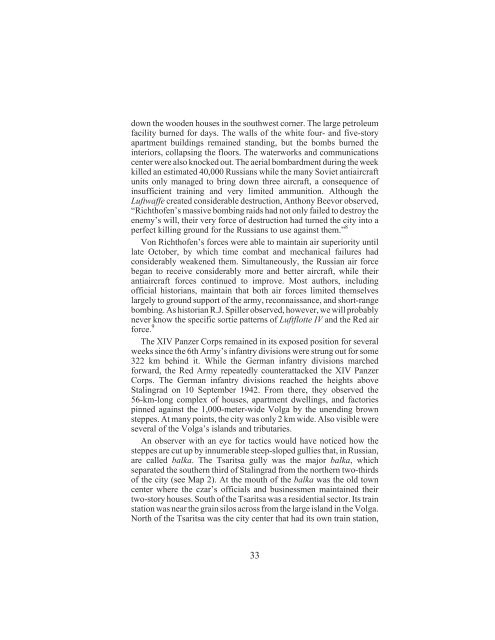SJ Lewis - Strategique.org
SJ Lewis - Strategique.org
SJ Lewis - Strategique.org
You also want an ePaper? Increase the reach of your titles
YUMPU automatically turns print PDFs into web optimized ePapers that Google loves.
down the wooden houses in the southwest corner. The large petroleum<br />
facility burned for days. The walls of the white four- and five-story<br />
apartment buildings remained standing, but the bombs burned the<br />
interiors, collapsing the floors. The waterworks and communications<br />
center were also knocked out. The aerial bombardment during the week<br />
killed an estimated 40,000 Russians while the many Soviet antiaircraft<br />
units only managed to bring down three aircraft, a consequence of<br />
insufficient training and very limited ammunition. Although the<br />
Luftwaffe created considerable destruction, Anthony Beevor observed,<br />
“Richthofen’s massive bombing raids had not only failed to destroy the<br />
enemy’s will, their very force of destruction had turned the city into a<br />
perfect killing ground for the Russians to use against them.” 8<br />
Von Richthofen’s forces were able to maintain air superiority until<br />
late October, by which time combat and mechanical failures had<br />
considerably weakened them. Simultaneously, the Russian air force<br />
began to receive considerably more and better aircraft, while their<br />
antiaircraft forces continued to improve. Most authors, including<br />
official historians, maintain that both air forces limited themselves<br />
largely to ground support of the army, reconnaissance, and short-range<br />
bombing. As historian R.J. Spiller observed, however, we will probably<br />
never know the specific sortie patterns of Luftflotte IV and the Red air<br />
force. 9<br />
The XIV Panzer Corps remained in its exposed position for several<br />
weeks since the 6th Army’s infantry divisions were strung out for some<br />
322 km behind it. While the German infantry divisions marched<br />
forward, the Red Army repeatedly counterattacked the XIV Panzer<br />
Corps. The German infantry divisions reached the heights above<br />
Stalingrad on 10 September 1942. From there, they observed the<br />
56-km-long complex of houses, apartment dwellings, and factories<br />
pinned against the 1,000-meter-wide Volga by the unending brown<br />
steppes. At many points, the city was only 2 km wide. Also visible were<br />
several of the Volga’s islands and tributaries.<br />
An observer with an eye for tactics would have noticed how the<br />
steppes are cut up by innumerable steep-sloped gullies that, in Russian,<br />
are called balka. The Tsaritsa gully was the major balka, which<br />
separated the southern third of Stalingrad from the northern two-thirds<br />
of the city (see Map 2). At the mouth of the balka was the old town<br />
center where the czar’s officials and businessmen maintained their<br />
two-story houses. South of the Tsaritsa was a residential sector. Its train<br />
station was near the grain silos across from the large island in the Volga.<br />
North of the Tsaritsa was the city center that had its own train station,<br />
33


